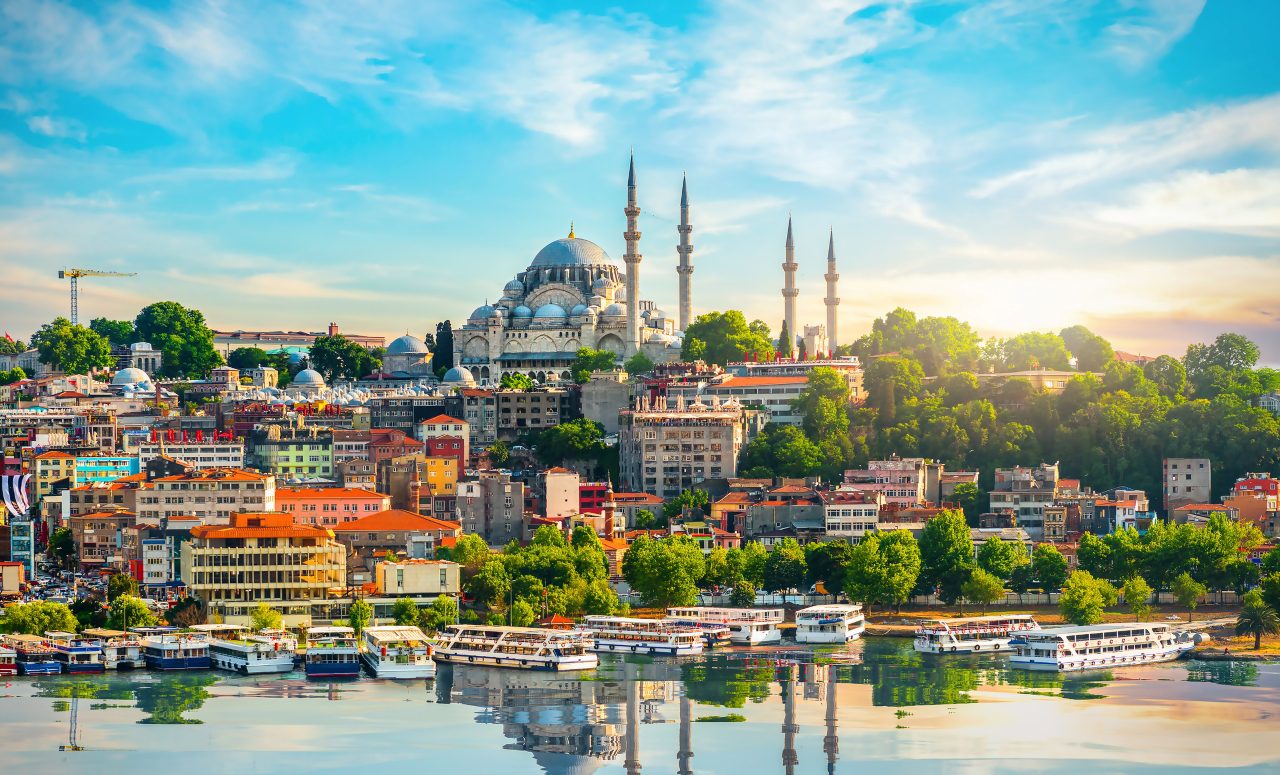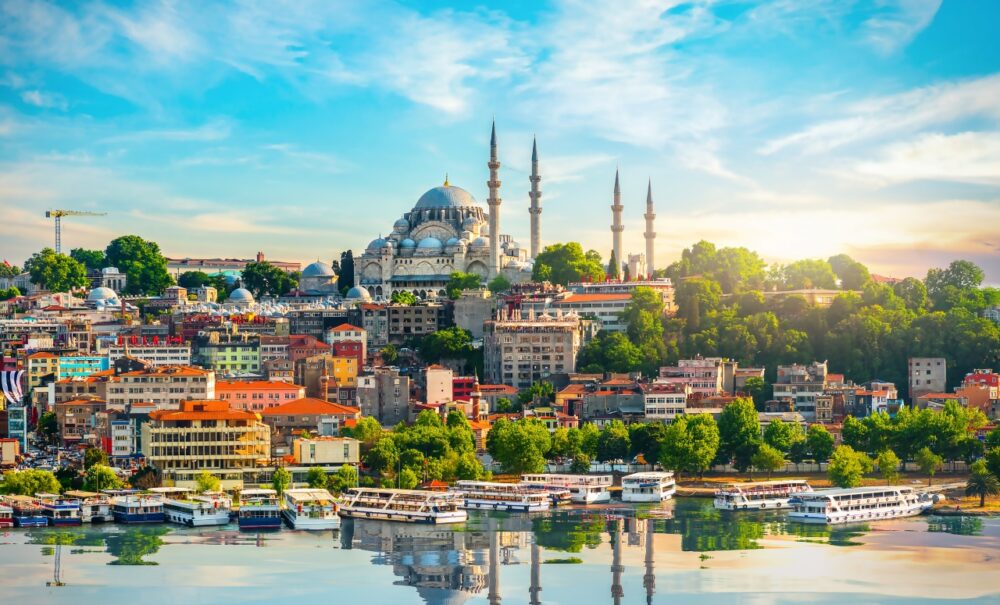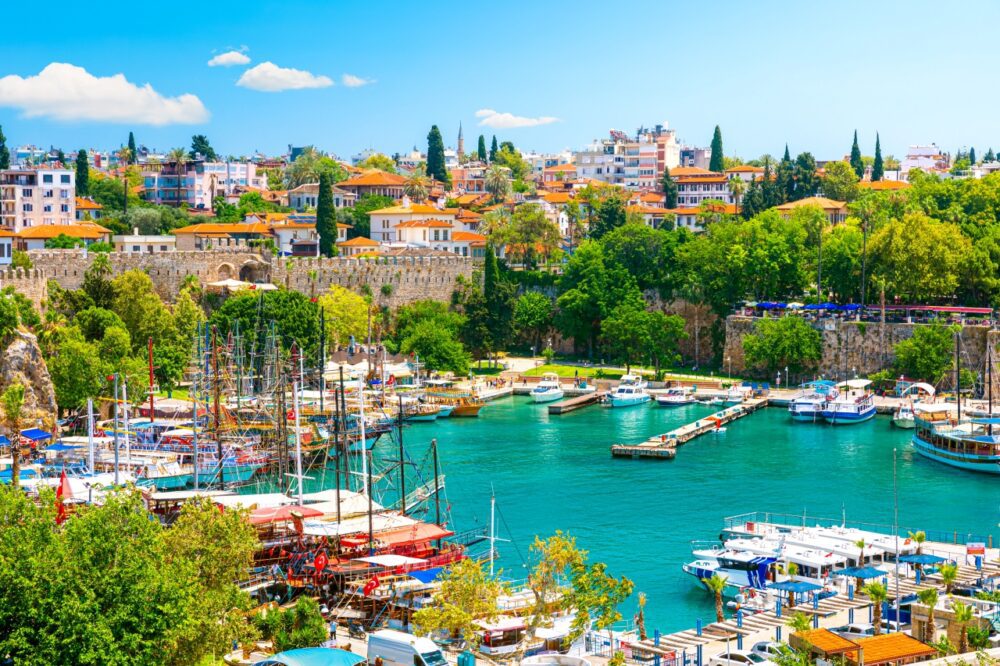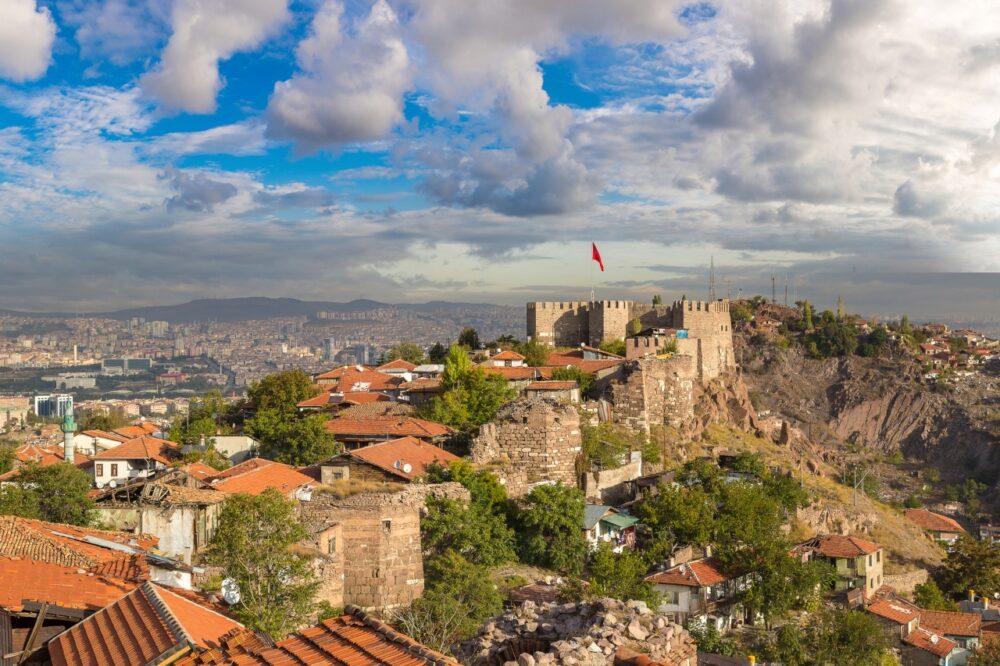
Introduction
Turkey is a country that truly has it all. Whether you’re after ancient history, stunning landscapes, vibrant cities, or simply a relaxing beach holiday, Turkey delivers on every level. With one foot in Europe and the other in Asia, this country blends cultures, traditions, and influences like nowhere else. The result is a destination where you can walk through Roman ruins in the morning, relax on a Mediterranean beach in the afternoon, and finish the day sipping tea in a bustling bazaar.
I first visited Turkey a few years ago, and it was one of those trips that stays with you. There’s a magic to this place that’s hard to describe—it’s in the warmth of the people, the mix of cultures, and the sheer variety of experiences you can have in one country. Whether you’re marvelling at the skyline of Istanbul or floating above the fairy chimneys of Cappadocia, Turkey will surprise and enchant you at every turn.
Table of Contents
Reasons You Should Visit Turkey
1. A Rich Cultural Heritage
Turkey has been at the crossroads of civilizations for millennia, and its history is as diverse as its landscapes. The country’s ancient ruins, grand mosques, and Byzantine churches tell the stories of empires that shaped not just Turkey, but the world. One moment, you’re wandering through Roman cities like Ephesus, and the next, you’re standing in the shadow of Ottoman grandeur in Istanbul’s Hagia Sophia.
What struck me most is how living history feels in Turkey. You’re not just visiting a museum—you’re walking through places where history unfolded. For example, Troy, famous from Homer’s Iliad, may have lost its mythical wooden horse, but standing among the ruins, you can almost imagine the epic battles that took place. Turkey’s rich heritage is everywhere, from the ruins of Pamukkale to the medieval castles of Bodrum.
2. Incredible Food and Hospitality
Few places in the world offer food as varied and delicious as Turkey. Whether it’s the sizzling kebabs of the cities, the fresh meze platters on the coast, or the sweet treats like baklava and lokum (Turkish delight), you’ll never go hungry. One of my favourite food experiences was in Antalya, where I tried freshly caught fish, grilled to perfection and served with a view of the Mediterranean.
What really makes the food special, though, is the hospitality. Turks are known for their generosity, and it’s not uncommon to be invited for a cup of çay (tea) or a home-cooked meal by people you’ve just met. I experienced this warmth in Cappadocia, where a local family invited me into their home for a meal of mantı (Turkish dumplings). Sharing a meal with them was one of the highlights of my trip and a reminder of how welcoming the people of Turkey are.
3. Breathtaking Landscapes
Turkey’s landscapes are as diverse as they are beautiful. From the surreal rock formations of Cappadocia to the turquoise waters of the Turkish Riviera, there’s no shortage of breathtaking scenery. One of the most magical experiences I had was taking a hot air balloon ride at sunrise over Cappadocia. Floating above the fairy chimneys and valleys, with the first light of day illuminating the otherworldly landscape, was something I’ll never forget.
If you prefer beaches, Turkey’s southern coast is paradise. The stretch of coastline from Fethiye to Antalya is known as the Turquoise Coast, and it’s easy to see why. Crystal-clear waters, secluded coves, and dramatic cliffs make it a perfect destination for swimming, sailing, or just lounging on the beach. For something completely different, head to Pamukkale, where you can soak in thermal pools that cascade down white limestone terraces. It’s a surreal sight, and one of Turkey’s most unique natural wonders.
4. Affordable Travel
Turkey is a destination that offers incredible value for money. Whether you’re a backpacker or looking for a more luxurious experience, you’ll find something to suit your budget. Accommodation, food, and transport are all very affordable compared to many European destinations, and you’ll get a lot of bang for your buck when it comes to quality.
In Istanbul, I stayed in a comfortable boutique hotel in Sultanahmet for a fraction of what I’d pay in other European capitals. Similarly, in Fethiye, I found a charming guesthouse with views over the Mediterranean that didn’t break the bank. Food, too, is reasonably priced—especially if you eat like the locals. Grab a simit (a Turkish sesame bagel) from a street vendor for breakfast, or sit down for a hearty gözleme (a savoury stuffed flatbread) at a local café.
5. A Blend of Old and New
One of the things I love most about Turkey is how it effortlessly blends the old with the new. In Istanbul, you can visit the ancient Blue Mosque in the morning and then spend the afternoon shopping for designer clothes in Nişantaşı. The city is a perfect microcosm of Turkey as a whole—a place where history and tradition coexist with modern life.
This contrast is also visible in smaller towns. In Bodrum, you’ll find sleek beach clubs and luxury yachts right next to ancient ruins and traditional markets. In Izmir, modern cafes line the waterfront, but venture a few blocks inland and you’ll find bustling bazaars selling everything from spices to handcrafted jewellery. Turkey’s ability to balance its rich past with its dynamic present is what makes it so endlessly fascinating.
Best Places to Visit in Turkey
1. Istanbul

No visit to Turkey is complete without experiencing Istanbul, the country’s largest and most vibrant city. Istanbul is a place where East meets West, and you can feel that energy everywhere—from the bustling markets to the historic mosques and palaces. One of the best ways to start your visit is by exploring the historic neighbourhood of Sultanahmet, home to the Hagia Sophia, Blue Mosque, and Topkapi Palace. I spent an entire day getting lost in the history of this area, and still felt like I’d only scratched the surface.
Another must-do is taking a ferry ride on the Bosphorus, the strait that divides the city between Europe and Asia. Watching the city’s skyline unfold as you cruise along the water is magical, especially at sunset. And no trip to Istanbul would be complete without a visit to the Grand Bazaar. It’s one of the largest and oldest covered markets in the world, and while it can be overwhelming, it’s also a fantastic place to shop for souvenirs, spices, and carpets.
2. Cappadocia
Cappadocia is one of the most surreal landscapes you’ll ever encounter. The region is famous for its fairy chimneys—tall, thin spires of rock that rise out of the ground like something from another planet. The best way to see this unique terrain is from the air. I took a hot air balloon ride at dawn, and watching the sun rise over the valleys was one of the most breathtaking experiences of my life.
On the ground, there’s plenty to explore as well. I spent a day hiking through the Rose Valley, where the rocks are a soft pink hue, and visited the ancient cave churches in the Goreme Open Air Museum. For a touch of history, don’t miss the underground cities of Derinkuyu and Kaymakli, where early Christians carved entire communities into the rock to escape persecution.
3. Antalya

If you’re after a beach holiday, Antalya is the place to be. Located on the Turkish Riviera, Antalya has a perfect mix of sun, sea, and history. The old town, known as Kaleiçi, is a charming maze of narrow streets, Ottoman-era houses, and ancient Roman ruins. I spent hours wandering through its alleys, discovering hidden cafés and small shops selling handmade crafts.
Antalya is also a great base for exploring the surrounding coast. One of my favourite day trips was to the ancient city of Termessos, which is perched high in the mountains. The hike to the top is steep, but the views and the sense of history are worth the effort. Back in Antalya, I relaxed on Konyaaltı Beach, a long stretch of pebbly coastline with crystal-clear waters and plenty of beachfront bars and restaurants.
4. Izmir
Izmir is Turkey’s third-largest city, and it has a laid-back, Mediterranean vibe that’s hard to resist. It’s a great place to enjoy a more modern side of Turkey while still being close to ancient wonders like Ephesus. I loved walking along the Kordon, Izmir’s waterfront promenade, where you can take in views of the Aegean Sea while stopping at cafés and restaurants along the way.
Izmir is also known for its lively bazaars, where you can shop for everything from spices to leather goods. Kemeralti Market is one of the best places to dive into the hustle and bustle of local life. And if you’re interested in history, take a short drive to the Asansör, a historic elevator that offers panoramic views of the city and sea.
5. Bodrum
Bodrum is where ancient history meets modern luxury. Famous for its sparkling blue waters, whitewashed houses, and vibrant nightlife, Bodrum is one of the most popular destinations on the Aegean coast. But there’s more to Bodrum than just beaches and bars. The Bodrum Castle, built by the Knights of St. John, is a must-visit for history lovers. The castle also houses the Museum of Underwater Archaeology, where you can see artefacts from ancient shipwrecks.
During my visit, I took a boat tour around the coast, stopping at secluded coves for swimming and snorkelling. If you’re a fan of sailing, Bodrum is a hub for gulet cruises, traditional wooden yachts that offer a relaxing way to explore the coast. After a day on the water, head to one of the many seafood restaurants along the marina and enjoy a meal with a view.
6. Fethiye
Fethiye is the gateway to some of the most stunning natural scenery in Turkey. The town itself is charming, with a relaxed vibe and a bustling marina. From Fethiye, I took a boat trip to Butterfly Valley, a hidden gem surrounded by towering cliffs. The beach here is pristine, and the valley is home to over 80 species of butterflies. Another highlight was hiking a section of the Lycian Way, a long-distance trail that runs along the coast.
For history lovers, Kayakoy, a ghost village just outside Fethiye, is a haunting reminder of Turkey’s complex past. The village was abandoned during the population exchange between Greece and Turkey in the 1920s, and today its crumbling stone houses are a poignant sight. Back in Fethiye, the Fethiye Market is a great place to sample local produce and pick up souvenirs.
7. Pamukkale
Pamukkale is one of Turkey’s most unique and visually striking destinations. Known as the “Cotton Castle,” this natural wonder is famous for its white terraces made of travertine, a form of limestone deposited by mineral springs. Walking barefoot along the terraces and soaking in the thermal pools is an otherworldly experience, especially at sunset when the light turns the landscape golden.
Pamukkale is also home to the ancient city of Hierapolis, which was founded as a thermal spa in the 2nd century BC. I explored the ruins of the theatre, baths, and the Necropolis, one of the largest ancient cemeteries in Turkey. For an unforgettable experience, take a dip in the Cleopatra Pools, where you can swim among ancient columns and ruins in warm, mineral-rich water.
8. Ankara

As Turkey’s capital, Ankara may not have the same romantic allure as Istanbul or the coast, but it’s a city full of culture and history. The highlight of my time in Ankara was visiting Anıtkabir, the mausoleum of Mustafa Kemal Atatürk, the founder of modern Turkey. The monument is an impressive tribute to one of the most important figures in Turkish history, and it’s surrounded by a peaceful park.
Ankara is also home to some of Turkey’s best museums. The Museum of Anatolian Civilizations is a treasure trove of artefacts from Turkey’s ancient past, and the Ethnography Museum offers a fascinating look at Turkish culture and traditions. While the city itself may not be as picturesque as others, it’s a great place to dive deeper into Turkey’s history and get a sense of its modern political heart.
9. Trabzon
Located on Turkey’s northern coast, Trabzon is a gateway to the lush, green landscapes of the Black Sea region. It’s a city that feels completely different from the sun-drenched Mediterranean, with misty hills, tea plantations, and cool mountain air. One of the main attractions here is the Sumela Monastery, an ancient Greek Orthodox monastery built into a cliff face. The hike up to the monastery is steep, but the views over the valley below are breathtaking.
Trabzon’s old town is also worth exploring, with its traditional wooden houses and bustling bazaars. The city is known for its rich history as a trading post on the Silk Road, and you can still feel that energy in the streets. I spent a morning wandering through the Trabzon Bazaar, where you can find everything from handwoven carpets to fresh Black Sea fish.
10. Olympos
Olympos, located on Turkey’s Mediterranean coast, is a place where history and nature come together in the most beautiful way. The ancient ruins of the Lycian city of Olympos are scattered among lush forests and rugged mountains, leading down to a pristine beach. I loved wandering through the ruins, imagining what life was like in this ancient city while surrounded by such stunning natural beauty.
The nearby Chimaera, a natural gas-fueled fire that has been burning on the mountainside for thousands of years, is another must-see. I hiked up to the site at dusk, and sitting by the flickering flames under a starry sky was an experience like no other. Olympos is also a great spot for eco-tourism, with treehouse accommodations and outdoor activities like rock climbing, canyoning, and sea kayaking.
Travel Tips for Turkey
Getting Around Turkey
Turkey has an extensive public transport system, making it easy to travel between cities. Buses are the most affordable option, with long-distance buses connecting cities like Istanbul, Ankara, and Izmir. Trains are slower but comfortable, particularly on scenic routes like the Eastern Express to Kars. In cities, dolmuş (shared minivans) are a cheap way to get around, and ferries are essential for navigating Istanbul’s waterways. Renting a car is a good option if you want to explore more remote areas like Cappadocia or the Turquoise Coast, but be prepared for chaotic city traffic.
Best Time to Visit Turkey
The best time to visit Turkey is in spring (April to June) and autumn (September to November) when the weather is pleasant, and the tourist crowds are smaller. These seasons are perfect for exploring historical sites like Ephesus or hiking in Cappadocia. Summer (July to August) can be very hot, especially in inland areas, but is great for beach holidays along the Aegean or Mediterranean coasts. Winter is the low season, with cool and rainy weather, but it’s a great time to explore Istanbul and experience the quiet charm of Cappadocia under snow.
Passport and Visa Requirements for Turkey
Travellers from many countries, including the US, UK, EU, Canada, and Australia, need an e-visa to enter Turkey. The process is simple and can be completed online before arrival. Citizens of some countries can enter visa-free or with an ID card. Your passport should be valid for at least six months beyond your planned stay. Be sure to check the visa requirements for your nationality in advance, as rules can change frequently.
Currency and Banks in Turkey
Turkey uses the Turkish Lira (TRY). ATMs are widely available in cities and towns, and credit cards are accepted in most hotels, restaurants, and shops. However, cash is still preferred in smaller towns or markets, so it’s good to carry some lira for everyday expenses. Exchange rates at airports tend to be poor, so use ATMs or local exchange offices in the city for better rates. Tipping is appreciated, usually 5-10% in restaurants, though small change for taxi drivers or hotel staff is also common.
Language and Useful Phrases to Know
The official language is Turkish, and while English is widely spoken in tourist areas, especially in Istanbul and along the coast, it’s helpful to know a few basic Turkish phrases. Try “Merhaba” (hello), “Teşekkür ederim” (thank you), and “Lütfen” (please). In rural areas, English is less common, so having some Turkish or a translation app handy can be useful. Locals are generally very friendly and appreciate when visitors make the effort to speak Turkish, even if it’s just a few words.
Budgeting and Costs for Turkey
Turkey offers great value for money compared to many European destinations. Accommodation, food, and transport are all affordable, especially outside major tourist hotspots like Istanbul. Street food, like simit (bagels) or kebabs, is cheap and delicious, while dining at local lokantas (small restaurants) provides excellent meals for low prices. Public transport, particularly buses, is budget-friendly. To save on attractions, consider purchasing a Museum Pass, which offers access to top sites like Topkapi Palace and Hagia Sophia for a discounted rate.
Conclusion
Turkey is a country that has something for everyone. Whether you’re drawn to the ancient ruins and rich history, the vibrant cities and cultural experiences, or the stunning natural landscapes, you’ll find that Turkey is a place that keeps surprising you. From the bustling streets of Istanbul to the tranquil beaches of the Mediterranean, and the surreal landscapes of Cappadocia, Turkey is a destination that will capture your heart and leave you wanting more.
What makes Turkey truly special, though, is the warmth and hospitality of its people. No matter where you go, you’ll be welcomed with open arms, and you’ll leave with a deeper appreciation for this beautiful and diverse country. So, if you’re looking for a destination that offers adventure, relaxation, and cultural richness in equal measure, look no further than Turkey.
